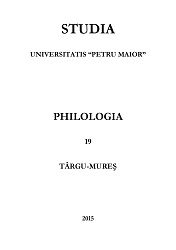Metaphorical Models, Cybergenres and User Strategic Modes in Virtual Space
Metaphorical Models, Cybergenres and User Strategic Modes in Virtual Space
Author(s): Carolina Girón-García, Ignasi Navarro i FerrandoSubject(s): Semiotics / Semiology, Pragmatics, Cognitive linguistics, Computational linguistics, ICT Information and Communications Technologies, Distance learning / e-learning
Published by: Editura Arhipelag XXI
Keywords: Digital literacy; Cybergenre; Idealized Cognitive Models (ICMs); Metaphor; Virtual space;
Summary/Abstract: In recent decades, new technologies have evolved so rapidly that the use of computers and the Internet has resulted in the appearance of a new type of genre, i.e. Cybergenre (Shepherd & Watters, 1998; Shepherd, Watters & Kennedy, 2004). The medium used by these new genres, their social role, their purpose, their audiences and kinds of skills required to their users differ from those of old genres, and therefore, cybergenres cannot be measured or characterized by means of the same parameters as traditional written (paper format) genres. On the other hand, some authors have described three types of “Reading Modes”, such as ‘Navigating’, ‘Browsing’, and ‘Reading’ (Girón-García, 2013), regarding different Internet users’ strategies. Our hypothesis is that the type of reading mode –or user strategic mode- not only has to do with types of users and their tendencies but also with the cybergenre itself, its configuration and the types of cognitive frames that it activates in users. Each particular genre activates certain metaphorical models –made apparent through metaphorical expressions– that configure the necessary paths for users to succeed in its adequate processing. In this context, our purpose here is to identify idiosyncratic metaphorical expressions that may guide the movement of the user thought texts precisely because they activate cognitive models. In turn, we provide descriptions of metaphorical models and try to explain and illustrate their coherence within particular genres. Therefore, our procedure consists firstly in selecting genres, such as on-line dictionaries and market sites, secondly identifying metaphorical expressions, and finally describing the models they activate, so that we can elucidate different user strategic modes (reading modes) for each genre type. We claim that different guiding metaphors of topological character (spatial) prompt different users’ techniques or strategies. In addition, we suggest that these metaphors provide internal coherence to the genres, as such.
Journal: Studia Universitatis Petru Maior. Philologia
- Issue Year: 2015
- Issue No: 19
- Page Range: 32-43
- Page Count: 12
- Language: English

